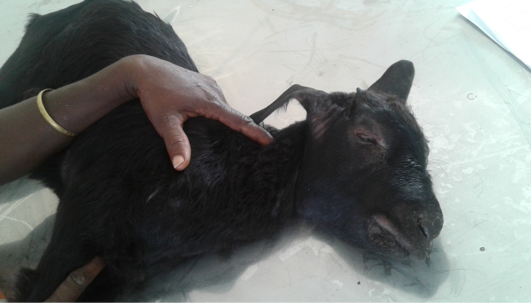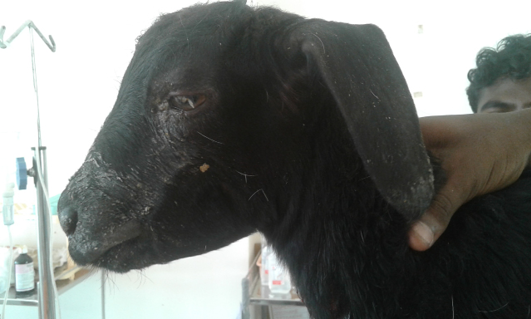Research Journal for Veterinary Practitioners
Short Communication
Wasp Bite Induced Angioedema and its Management in a Lamb
Enbavelan Angappan, Mohanambal Kaliyannan, Ramkumar Premkumar, Saranyaa, Ramprabhu R
Department of Veterinary Medicine, Veterinary College and Research Institute, Tamilnadu Veterinary and Animal Sciences University, Tirunelveli.
Abstract | A six month old non – descriptive lamb was presented to Medicine unit of Teaching Veterinary Clinical Complex, Tirunelveli for treatment with the history of wasp bite three days back and the animal having facial swelling, purulent discharge from both the eyes and nostrils. Clinical examination revealed swollen face and eyelid and the animal having respiratory distress. The lamb was treated with anti-histamine, fluid therapy and corticosteroids. The animal recovered completely within five days.
Keywords | Angioedema, Antihistamine, Corticosteroid, Lamb, Wasp sting
Editor | Muhammad Abubakar, National Veterinary Laboratories, Islamabad, Pakistan.
Received | June 02, 2016; Accepted | June 20, 2016; Published | July 18, 2016
aInternship student.
*Correspondence | K Mohanambal, Assisctant Professor, Department of Veterinary Medicine, Veterinary College and Research Institute, Tamilnadu Veterinary and Animal Sciences University, Tirunelveli; Email: [email protected]
Citation | Enbavelan PA, Mohanambal K, Ramkumar PK, Saranya S, Ramprabhu R (2016). Wasp bite induced angioedema and its management in a lamb. Res. J. Vet. Pract. 4(3): 47-48.
DOI | http://dx.doi.org/10.14737/journal.rjvp/2016/4.3.47.48
ISSN | 2308-2798
Copyright © 2016 Enbavelan et al. This is an open access article distributed under the Creative Commons Attribution License, which permits unrestricted use, distribution, and reproduction in any medium, provided the original work is properly cited.
Deaths from Bee stings are uncommon Allergic reactions may occur which will be vary from localized painful, itchy swellings to generalized urticarial and anaphylactic shock (Riches et al., 2002). Wasp stings are usually not fatal. The commonest manifestations are related to allergy and low grade systemic reactions characterized by pain, swelling, urticaria and redness at the sting site that usually lasts for 1-2 days. Large local reactions are late phase manifestations that may involve a large area and persist up to a week. They are not life threatening unless they involve the airway. In such an incident, death was due to an anaphylactic shock and suffocation after stings in the airways (Saukko et al., 2004). The estimated lethal dose was approximately 20 stings / kg in most mammals. Bee and wasp venoms are made up primarily of protein, generally categorized as high molecular weight proteins that includes phospholipases, hyaluronidases, antigen, low molecular weight peptides that includes mastoparans, wasp kinins and chemotactic peptides and bioactive molecules such as histamine, serotonin, catecholamines, acetylcholine, and tyramine. Treatment of uncomplicated envenomations (stings) consists of conservative therapy (antihistamines, ice or cool compresses, topical lidocaine, or corticosteroid lotions) (Fitzgerald and Flood, 2006). The present case describes the successful treatment of wasp bite induced angioedema in a Lamb.
A six month old non – descriptive lamb weighing 6.5 kg was presented to Medicine section of Teaching Veterinary Clinical Complex, Veterinary College and Research Institute, Tirunelveli, with the history of wasp bite, after that the lamb not taking feed and water. Clinical examination of the animal revealed angioedema of face and neck region. On palpation of the face revealed bilateral eyelid swelling and edema which pits on pressure, congested mucus membrane, engorged scleral vessels and purulent discharge from both the nostrils. The animal also had shallow inspiration and forceful expiration. Vital sign parameters revealed high body temperature (104.1 F), slightly increased respiration rate (28 / minute), elevated heart rate (220 beats / minute) and capillary refilling time (CRT) - more the 4 seconds. Whole blood clotting time was 7 minutes.
The lamb was treated with injection Chlorpheneramine maleate 2 ml intra muscularly as a antihistaminic, injection prednisolone @ 1 mg / kg intra muscularly as a lifesaving drug. To compensate the fluid loss, fluid therapy was given @ 60 ml / kg with dextrose normal saline 240 ml intravenously to reduce the dehydration percentage, loop diuretic Frusemide given intravenously @ the dose rate of 2.5 mg / kg to reduce the edema and to control secondary antibacterial infection antibiotic Streptopenicillin given @ 10000 IU / kg body weight intra muscularly for 3 days, injection Multivitamin given as a supportive therapy @ 30 mg / kg for 3 days.
As per Ewan (1985), the commonest wasp venom induces pruritus, urticarial, angio-oedema and asthma. Arthropod bites and stings are capable of inflicting injury, allergic reactions and transmitting infectious diseases. Hymenoptera order members are particularly important because of being nearly ubiquitous in nature. Their stings may lead to fatal allergic reactions (Rayamana et al.,2014). The majority of hymenopteran stings are self-limiting events, sometimes therapy needed with antihistaminic with corticosteroids (Fitzgerald and Flood, 2006)
Conflict of interests
There is no conflict of interest.
Authors’ contribution
All authors contributed equally.
References








